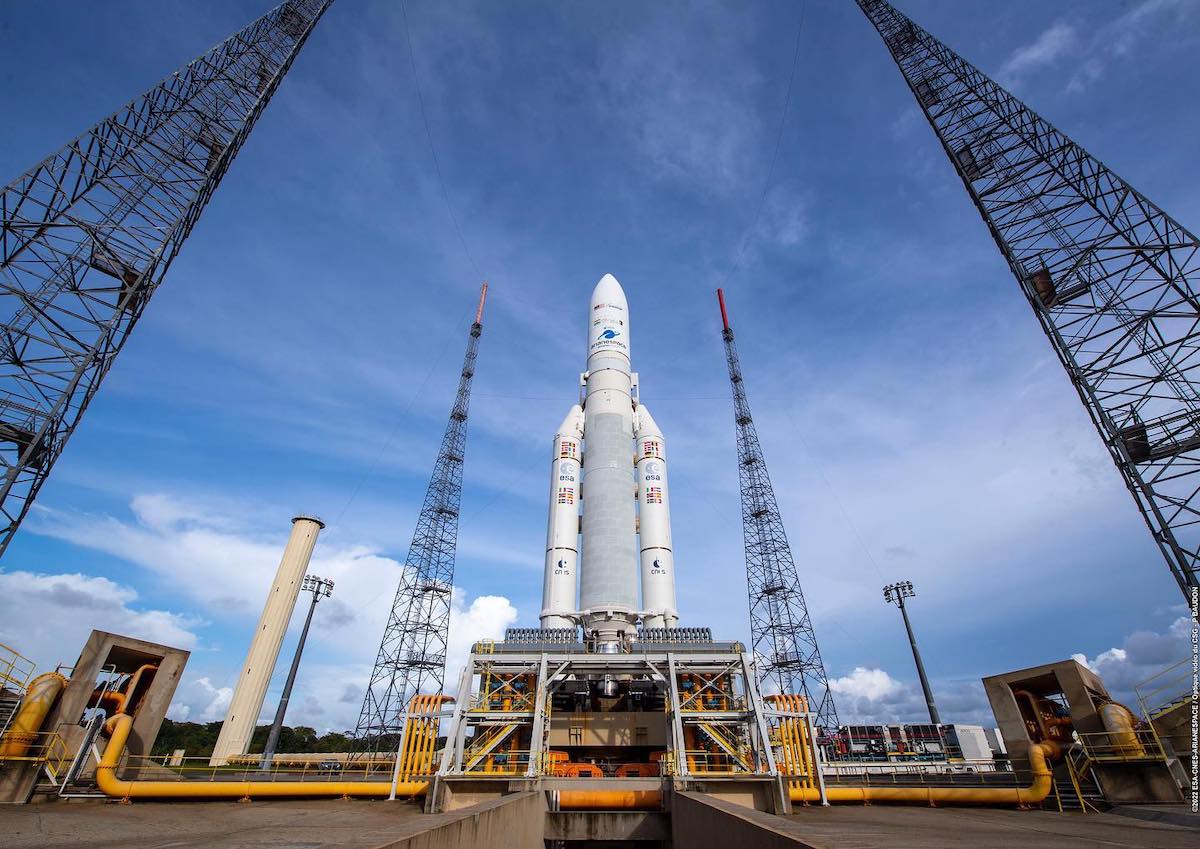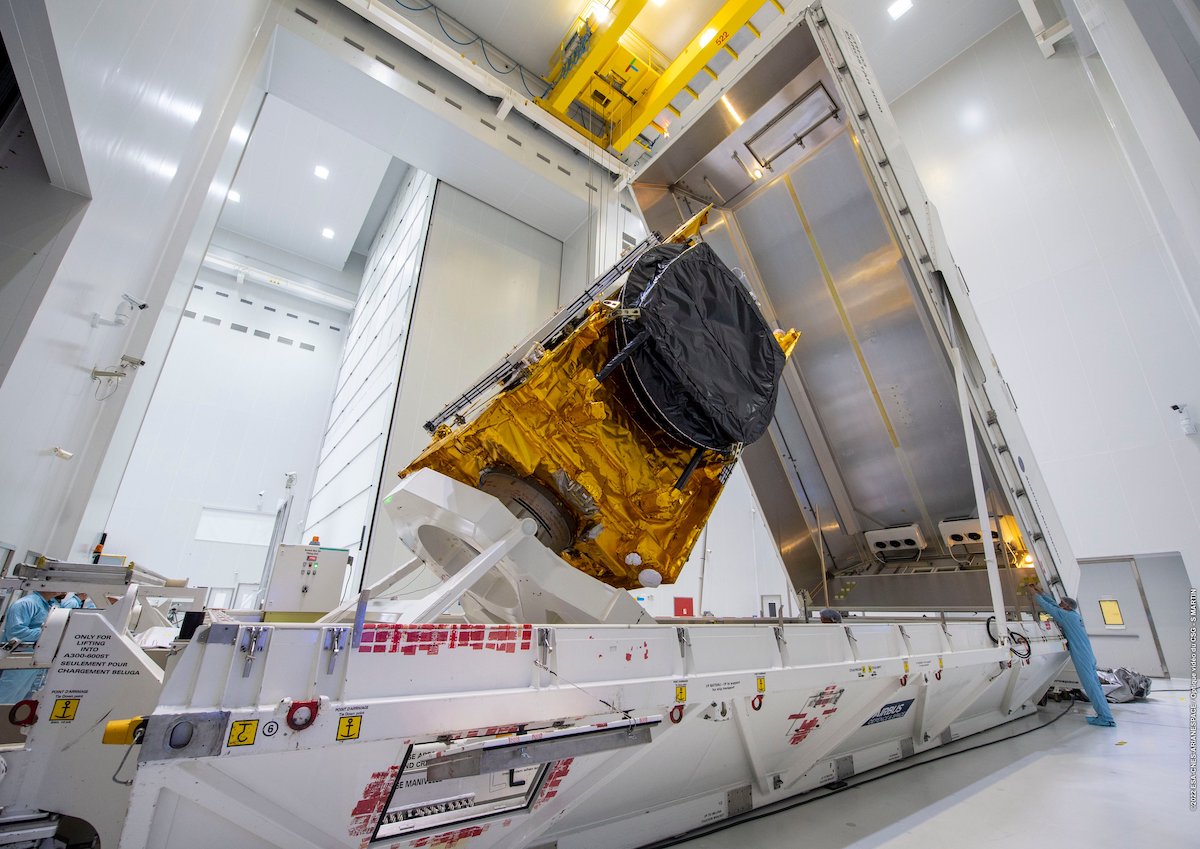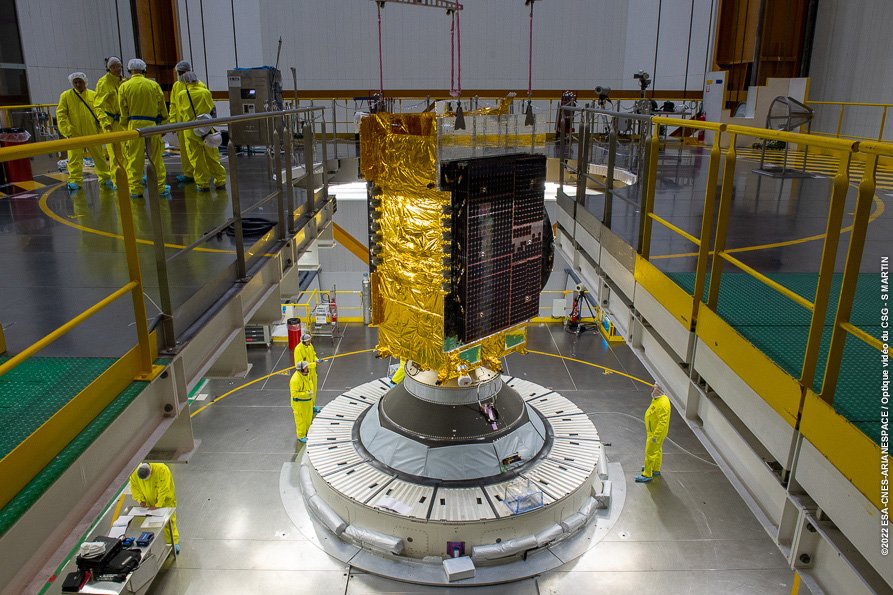
Two geostationary communications satellites for India’s space agency and a Malaysian company will rocket into orbit from the jungle of South America on Wednesday on a European-built Ariane 5 launcher.
The launch window Wednesday opens at 5:03 p.m. EDT (2103 GMT; 6:03 p.m. French Guiana time) and extends until 6:43 p.m. EDT (2243 GMT; 7:43 p.m. French Guiana time).
Arianespace, the French launch service company, transferred the Ariane 5 rocket from the final assembly building to the ELA-3 launch zone at the Guiana Space Center on Tuesday. The mission Wednesday will be the first flight of an Ariane 5 rocket this year, and the first since the launch of the James Webb Space Telescope on Dec. 25.
The launch will mark the 257th flight of an Ariane rocket since 1979, and the 113th launch of an Ariane 5 rocket since 1996. It’s also one of five Ariane 5 flights remaining before Arianespace retires the rocket for replacement by the next-generation Ariane 6 launcher.
The Ariane 5 launch team at the spaceport in Kourou, French Guiana, plans to load cryogenic liquid hydrogen and liquid oxygen propellants into the rocket’s core stage and upper stage Wednesday, leading to the start of the final seven-minute automated launch sequence.
The 180-foot-tall (55-meter) rocket’s Vulcain 2 core stage engine will fire as the countdown clock reaches zero, beginning a seven-second checkout before the Ariane 5 lights its twin solid rocket boosters to begin the climb into space.
The Ariane 5 will head east over the Atlantic Ocean, riding 2.9 million pounds of thrust for the first two minutes of the flight. The twin boosters will burn out and jettison, leaving the cryogenic core stage to burn until the nine-minute mark of the mission.
The core stage will separate to fall into the Atlantic Ocean off the coast of Africa, and the upper stage will ignite its HM7B engine to send the MEASAT 3d and GSAT 24 communications satellites into an elliptical, or oval-shaped, geostationary transfer orbit.

MEASAT 3d, weighing 12,451 pounds (5,648 kilograms), will deploy from the upper position in the Ariane 5 rocket’s dual-payload stack. The rocket will jettison a Sylda payload adapter structure to reveal the 9,217-pound (4,181-kilogram) GSAT 24 communications satellite for separation about 40 minutes after liftoff, completing the launch phase of the mission.
The Ariane 5 rocket will aim to deliver the MEASAT 3d and GSAT 24 satellites into an orbit ranging between 155 miles (250 kilometers) and 22,236 miles (35,786 kilometers) in altitude, with an inclination of 6 degrees to the equator.
The satellites will use on-board thrusters to circularize their orbits at geostationary altitude more than 22,000 miles over the equator, where their speeds will match the rate of Earth’s rotation.
MEASAT 3d, built in Europe by Airbus, is beginning a mission designed to last at least 18 years for the Malaysian telecom company MEASAT. The new spacecraft will be co-located with two other MEASAT satellites at 91.5 degrees east longitude.
According to MEASAT, the new satellite will provide broadband internet and direct-to-home television broadcast services across Malaysia and the broader Asia-Pacific region. MEASAT 3d carries C-band, Ku-band, and Ka-band communications payloads.
The $272 million (1.2 billion Malaysian ringgit) satellite is based on Airbus’s Eurostar 3000 spacecraft bus.

MEASAT 3d also hosts an L-band navigation augmentation payload for South Korea to reduce errors in GPS navigation data and improve air traffic control. A Q/V-band payload on the satellite will allow MEASAT to study signal propagation effects in high rainfall regions like Malaysia, enabling the design of next generation satellites, according to Airbus.
The GSAT 24 satellite is launching to begin a 15-year mission providing direct-to-home television programming to Indian consumers.
The spacecraft is riding in the lower position on the Ariane 5’s dual-payload stack, and heading for an operating position in geostationary orbit at 83 degrees longitude. GSAT 24 was built by the Indian Space Research Organization, India’s space agency. The satellite is owned and operated by NewSpace India Limited, or NSIL, the commercial arm of ISRO.
NSIL has leased TV broadcast capacity on GSAT 24 to M/s Tata Play, a direct-to-home television provider that says it offers more than 600 channels to more than 23 million users across India.

GSAT 24’s communications payload consists of 24 Ku-band transponders. ISRO said the GSAT 24 satellite is India’s first “demand-driven” mission after recent government reforms transitioning the country’s space program to a more market-based orientation, rather than a government-driven paradigm.
MEASAT 3d and GSAT 24 arrived in May at the Guiana Space Center from their factories in France and India. Teams fueled the satellites with maneuvering propellants before positioning them on top of the Ariane 5 launcher.
Email the author.
Follow Stephen Clark on Twitter: @StephenClark1.
